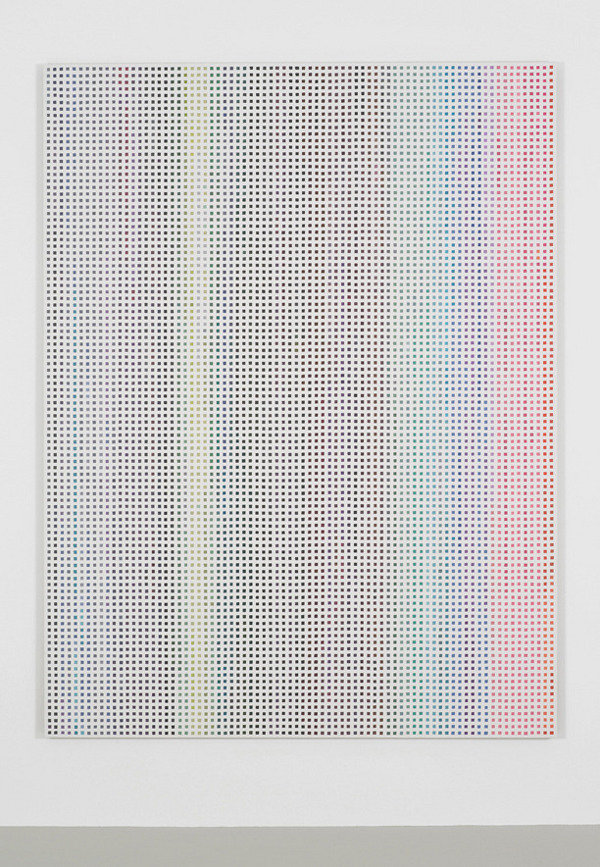Cheyney Thompson
dal 6/6/2014 al 25/7/2014
Segnalato da
6/6/2014
Cheyney Thompson
Campoli Presti, London
"10M/1000 ML/10 L" Drunks. A variant of such a random walk algorithm is put to work in this exhibition in order to produce paintings and sculptures.

Under the title "10M/1000 ML/10 L" Drunks Cheyney Thompson (* 1975, lives in New York) presents in his fourth fifth solo exhibition at Galerie Buchholz Campoli Presti a group of new paintings, drawings and sculptures.
The science of economics developed in the eighteenth and nineteenth centuries predominantly in the medium of language. The impact of set theoretical and topological reasoning after World War II finally put this verbal tradition to an end. Paralleled by the mathematization of economics from the 1950’s onwards, finance slowly moved from the margins of curricula at business schools to the center of value production. Its rise during the 1990’s marks the technical actualization – mathematical models drawn with pencil on paper were put to the test with the help of computers – of an epistemic shift, which has been in prolonged hibernation. As early as in 1900, Louis Bachelier discusses in his doctoral thesis “The Theory of Speculation” the application of stochastic processes to evaluate stock options. It has since marked the most general strand, that has not only transformed the study of finance, but the functioning of markets themselves.
Bachelier's main thesis is that the prices of stocks and similar securities follow a random walk and therefore the mathematical theory of probability can be applied, which was complemented in the 1960’s by an argument that explicated this. Prices follow a random path, since any information available prescribes their development. This is taken into account by speculators and thus cancelled out. Markets are efficient and only therefore subject to the arithmetics of chance.
A variant of such a random walk algorithm is put to work in this exhibition by Cheyney Thompson in order to produce paintings and sculptures. With regards to the paintings on view, its meander is placed into a three-dimensional colour-system conceptualized by Albert Munsell at the turn of the last century, which has been deployed by Thompson during the past years in order to tie his practice to the possibility of a rigorous quantification of colour. The algorithm is programmed to cover a distance of 10 meters 8032 steps. The diverse positions the line drawn by it within the solid of Munsell’s ten primaries colour model can be translated into amounts of different hues, saturations and values – milliliters square centimetres– Thompson finally applies on canvas. The algorithm – as a model which produces nothing but colour quantities and as information the beholder knows about – withdraws the surfaces of the tableaux from the possibility to read their compositions as indices of intention. Painted in a colour-spectrum in fact recommended by Munsell for reproduction, they negate from the start their singular sensual presence. The articulated brush traces, which ought to do nothing but spend the material, apparently struggle to escape the habitus of the painter. They are fraudulent in the sense that they cannot become an object of judgement. This is precisely so because one cannot even confirm by merely looking at them the application of their rule.
What they produce is a perspective from which the painter as well as the viewer are excluded. They are opaque, not where their redundant materiality becomes visible, but by means of their reduction to an abstract informatization, which mirrors the intangibility of economic processes that they nonetheless break down within the finite form of painting: a test pad for the non-liveable. It is the same algorithm Thompson resorts to for a set of sculptures. Whereas the paintings apparently take up the monstrous heritage of materialism, as it was first tentatively worked through by Impressionism, the sculptures appear to resume modernist painting’s debt to architecture. A one inch cube, as its elemental form of volume, is made to multiply itself on the algorithm’s path. Mimicking Parametricism’s contemporary triumphal lingo, which announces itself as the new global style of building, wearing the old mask of cast concrete, the bends and windings the cube stutters along produce shapes whose orientation remain unfathomable. To place those objects on the ground or on pedestals, whatever they might be doing there, expose them to gravity, let them crack, remains the only reasonable, maybe vital idiocy. The sculptures’ program is ended at somewhat contingent points. Most models have broken underneath their own weight. What would it mean to not give in? It is the only way out from becoming fatalistic.
Simon Baier
Cheyney Thompson’s work is part of the permanent collections of MoMA, New York and Centre Pompidou, Paris. He recently had a solo survey exhibition at the MIT List Visual Arts Center, Massachusetts with an accompanying monograph and was included in the 2008 Whitney Biennial. Past exhibitions include The Complete Reference: Pedestals and Drunken Walks (solo) at Kunstverein Braunschweig, Chat Jet - Painting ‘Beyond’ The Medium at Künstlerhaus Graz; The Indiscipline of Painting at Tate St Ives; Systems Analysis at West London Projects and Langen Foundation, Germany; Greater New York at P.S.1 Contemporary Art Center and Clandestine at The Venice Biennial 2003.
For further information or images please contact cora@campolipresti.com
Campoli Presti
223 Cambridge Heath Rd London E2 0EL
Tuesday to Friday, 10.30 am – 6.30 pm
Saturday 11 am – 6 pm
Sunday (during exhibitions) 12 pm - 6 pm



